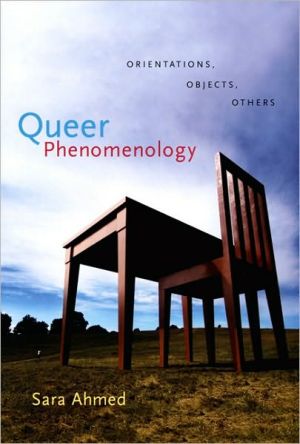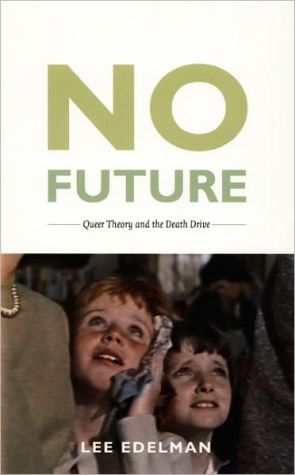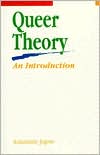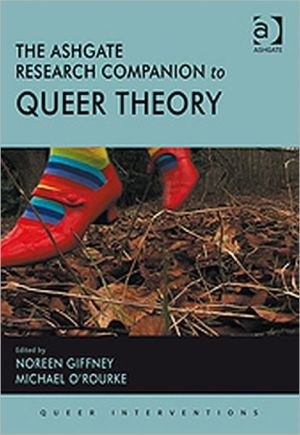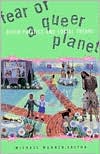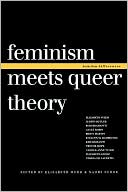Queer Phenomenology: Orientations, Objects, Others
In this groundbreaking work, Sara Ahmed demonstrates how queer studies can put phenomenology to productive use. Focusing on the “orientation” aspect of “sexual orientation” and the “orient” in “orientalism,” Ahmed examines what it means for bodies to be situated in space and time. Bodies take shape as they move through the world directing themselves toward or away from objects and others. Being “orientated” means feeling at home, knowing where one stands, or having certain objects within...
Search in google:
Theoretical study of the spatialization of sexuality through a consideration of how the "orientation" of bodies within a social space informs concepts of sexual desire.
QUEER PHENOMENOLOGY\ Orientations, Objects, Others \ \ By Sara Ahmed \ DUKE UNIVERSITY PRESS\ Copyright © 2006 Duke University Press\ All right reserved. \ ISBN: 978-0-8223-3861-1 \ \ \ \ Chapter One\ Orientations Toward Objects \ In perception properly so-called, as an explicit awareness (Gewahren), I am turned towards the object, to the paper, for instance, I apprehend it as being this here and now. The apprehension is a singling out, every perceived object having a background in experience. Around and about the paper lie books, pencils, ink-well, and so forth, and these in a certain sense are also "perceived," perceptually there, in the "field of intuition." Edmund Husserl, Ideas\ Phenomenology is often characterized as a "turn toward" objects, which appear in their perceptual "thereness" as objects given to consciousness. Rather than consciousness being seen as directed toward itself, it is understood as having objects in its view-as being shaped by that which appears before it in "this here and now." But in turning toward objects, what actually appears within phenomenological writing? If phenomenology apprehends what is given to consciousness, then what is given within the writing about that apprehension? Or, in simpler terms, what objects appear within phenomenology as objects that thereader, in turn, can apprehend?\ In Husserl's Ideas objects do appear for sure, though we cannot assume that they record an experience, in the sense that we cannot assume that Husserl saw or even "could see" the object at the moment of writing. As with much philosophy, the object appears in the language of "say" or "for instance": that is, "say, I see this"; or "for instance, I see that." Such words preface the example as illustration and not anecdote-the point is not whether or not this really happened. The object appears not as a thing to which we should, as readers, direct our attention; it is not so much a thing as a way of saying something. And yet objects still become apprehended in the reading as if they were what Husserl was himself directed toward; the as if makes the objects matter not "in themselves," or even "for themselves," but as that which the writing is "around." The objects do not take the shape of an event, in the sense of recording something that happens or is happening, even though they allow phenomenology to take the shape that it does.\ And yet, as Husserl notes, the object that is "singled out," or becomes available as a singular given, is "the paper," earlier described as "this white paper" (116). The object is an object that one imagines "would have been" in front of Husserl in the moment of writing, or even that "must have been" before him if the writing were to be written. We know enough about the "timing" of Husserl's writing to know, for instance, that what was in front of him was paper rather than a screen. Of course, the paper that Husserl might apprehend is not available to the reader. The paper can only be "missed" given that it is first apprehended as an object in the writing, which itself is dependent on the availability of paper. This paper weaves together the book I read as Husserl's book, and it was not available or "thrown" into Husserl's world as that which could appear to him. This paper, which was not given to him, must nevertheless be given in order for Husserl's writing to be given to me. I read writing printed on paper, and on the paper I read about the paper that is apprehended by Husserl. The paper is also "in" the writing, and hence the writing is "around" the paper. Around the paper are other objects, which are not singled out and thus form the "background" against and through which the paper appears. These again are tools of writing: inkwell, books, and pencils. The field of background intuition, against which the object becomes posited as given (the paper) provides for Husserl the very "stuff" for writing, the very materials out of which his phenomenology is borne.\ How does the "matter" of the paper matter? How does the orientation of the paper, which is "on" the writing table, also function as an orientation device, which both shows the "direction" of phenomenology and also takes it in a certain direction? In this chapter I explore the concept of orientation by engaging with the work on objects by Husserl, Heidegger, and Merleau-Ponty, as well as Marx. By reflecting specifically on "the table" as an object that matters within phenomenology, I also offer an account of gender as orientated. My aim is not to develop a phenomenology of sexual difference, as this has already convincingly been offered by feminist philosophers (see Beauvoir 1989; Young 1990, 2005; Heinämaa 2003; Fisher and Embree 2000). Instead, by showing how phenomenology faces a certain direction, which depends on the relegation of other "things" to the background, I consider how phenomenology may be gendered as a form of occupation.\ Objects of Perception\ The radical claim that phenomenology inherits from Franz Brentano's psychology is that consciousness is intentional: it is directed toward something. This claim immediately links the question of the object with that of orientation. First, consciousness itself is directed or orientated toward objects, which is what gives consciousness its "worldly" dimension. If consciousness is about how we perceive the world "around" us, then consciousness is also embodied, sensitive, and situated. This thesis does not simply function as a general thesis, but can also help show us how bodies are directed in some ways and not others, as a way of inhabiting or dwelling in the world.\ We are turned toward things. Such things make an impression upon us. We perceive them as things insofar as they are near to us, insofar as we share a residence with them. Perception hence involves orientation; what is perceived depends on where we are located, which gives us a certain take on things. Merleau-Ponty makes this point directly when he suggests that "the word perception indicates a direction rather than a primitive function" (1962: 12). Perception is a way of facing something. I can perceive an object only insofar as my orientation allows me to see it (it must be near enough to me, which in turn means that I must be near enough to it), and in seeing it, in this way or that, it becomes an "it," which means I have already taken an orientation toward it. The object is an effect of towardness; it is the thing toward which I am directed and which in being posited as a thing, as being something or another for me, takes me in some directions rather than others.\ For example, say I perceive something before me. In perceiving the object as an object, I perceive the object in a certain way, as being some kind of thing. Perceiving an object involves a way of apprehending that object. So it is not just that consciousness is directed toward objects, but also that I take different directions toward objects: I might like them, admire them, hate them, and so on. In perceiving them in this way or that, I also take a position upon them, which in turns gives me a position. I might perceive an object as beautiful, for instance. Such a perception affects what I do: if I have this impression, then I might pick up the object, or get closer to it, and even press it nearer to me. Orientations involve directions toward objects that affect what we do, and how we inhabit space. We move toward and away from objects depending on how we are moved by them. For Husserl, the interpretation of the object as having this or that property is a secondary act involving what he calls a "two-fold directedness" (1969: 122). First, I am directed toward an object (I face it), and then I take a direction toward it (for instance, I might or might not admire it). While directionality might be twofold, this "twofoldness" does not necessarily involve a sequence in time: in seeing the object I already apprehend it in a certain way, as a concrete "it" that has qualities that might attract or repel me, or even leave me indifferent, which might affect how "it" enters my view and whether it stays in view or passes from view. Turning toward an object turns "me" in this way or that, even if that "turn" does not involve a conscious act of interpretation or judgment.\ We might ask, then, which way does Husserl turn? If Husserl turns toward certain objects in his writing, then what does this tell us in turn about his phenomenology? Let us start where he starts in his first volume of Ideas, which is with the world as it is given "from the natural standpoint." Such a world is the world that we are "in," as the world that takes place around us: "I am aware of a world, spread out in space endlessly" (1969: 101). This world is not simply spread out; rather, it has already taken certain shapes, which are the very form of what is "more and less" familiar: As Husserl states: "For me real objects are there, definite, more or less familiar, agreeing with what is actually perceived without being themselves perceived or even intuitively present. I can let my attention wander from the writing-table I have just seen and observed, through the unseen portions of the room behind my back to the veranda, into the garden, to the children in the summer-house, and so forth, to all the objects concerning which I precisely 'know' that they are there and yonder in my immediate co-perceived surroundings" (101).\ The familiar world begins with the writing table, which is in "the room": we can name this room as Husserl's study or as the room in which he writes. It is from here that the world unfolds. He begins with the writing table and then turns to other parts of the room, those that are, as it were, behind him. To make this turn, we might suppose that he would have to turn around if he is to face what is behind him. But, of course, Husserl does not need to turn around as he "knows" what is behind him. And yet his mind wanders, as if thoughts are actions that demand that he turn around to face or "attend" to what is behind him. The verb "wander" helps us track the significance of "attention" as a mode of "turning toward." To "wander" can mean to ramble without certain course, to go aimlessly, to take one direction without intention or control, to stray from a path, or even to deviate in conduct or belief. So Husserl in attending to what is behind him is deviating from his proper course. The behind is here the "point" of deviation, such that when Husserl considers what is behind his back, he is turning his attention away from what he faces.\ We are reminded that what we can see in the first place depends on which way we are facing. What gets our attention depends too on which direction we are facing. The things that are behind Husserl are also behind the table that he faces: it is "self-evident" that he has his back to what is behind him. We might even say that it is the behind that converts "the back" into the background. A queer phenomenology, I wonder, might be one that faces the back, which looks "behind" phenomenology, which hesitates at the sight of the philosopher's back. Having begun here, with what is in front of his front and behind his back, Husserl then turns to other spaces, which he describes as rooms, and which he "knows" are there insofar as they are already given to him as places by memory. These other rooms are co-perceived: that is, they are not singled out and they do not have his attention, even when he evokes them for the reader. They are made available to us only as background features of this domestic landscape. Husserl's writing makes an impression on me when he offers this glimpse of the domesticity of his world. How I long for him to dwell there by lingering on the folds of the materials that surround him. How I long to hear about the objects that gather around him, as "things" he does "things" with. This is not a desire for biography, or even for an impossible intimacy with a writer who is no longer with us. This is, rather, a desire to read about the particularity of the objects that gather around the writer. It is also a desire to imagine philosophy as beginning here, with the pen and the paper, and with the body of the philosopher, who writes insofar as he is "at home" and insofar as home provides a space in which he does his work.\ Yes, we are invited, at least temporarily, to imagine the world that is his home; to give it a face and a form. I see his desk in the corner. I see him at his desk-leaning, writing, pressing pen to paper, creating the lines that make these impressions available to me. I see a leather chair to one side. I have such an image, such an impression already in mind. The study, the room dedicated to writing or other forms of contemplation, conjures up such a vivid image of a masculine domain at the front of the house. I imagine the furniture (dark, polished), the materials (leather, wood), and the feel of the room (serious, intense), even though I know I do not and will not know how he arranged his room. His words help to create these impressions. But my impression of this study does not begin with the words written on this paper. My impressions are affected by other books I have read in my own literary genealogy, especially nineteenth-century women's writing, which is saturated with images of domestic space. The study, the parlor, the kitchen: these rooms provide the settings for drama; they are where things happen.\ The family home provides, as it were, the background against which an object (the writing table) appears in the present, in front of Husserl. The family home is thus only ever co-perceived, and allows the philosopher to do his work. This familiar place, the family home, is also a practical world: "Things in their immediacy stand there as objects to be used, the 'table with its books,' the 'glass to drink from,' the 'vase,' the 'piano,' and so forth" (1969: 103). If Husserl is facing the writing table, then this "direction" also shows us the nature of the work that he does for a living. It is the table, with its books, which first gets his attention. As Diana Fuss reminds us, "the theatre of composition is not an empty space but a place animated by the artefacts, momentos, machines, books, and furniture that frame any intellectual labour" (2004: 1).\ The objects that first appear as the "more and less familiar" function as signs of orientation: being orientated toward the writing table might ensure that you inhabit certain rooms and not others, and that you do some things rather than others. In the following sections I will take up the significance of this example in terms of "doing things" and "inhabiting spaces." Being orientated toward the writing table not only relegates other rooms in the house to the background, but also might depend on the work done to keep the desk clear. The desk that is clear is one that is ready for writing. One might even consider the domestic work that must have taken place for Husserl to turn to the writing table, and to be writing on the table, and to keep that table as the object of his attention. We can draw here on the long history of feminist scholarship about the politics of housework: about the ways in which women, as wives and servants, do the work required to keep such spaces available for men and the work they do (Gilman 2002). To sustain an orientation toward the writing table might depend on such work, while it erases the signs of that work, as signs of dependence. In Ruth Madigan and Moira Munro's critique of the town house, they note how its interior design "reflected the internal hierarchy of the bourgeois family with the public 'masculine' domain at the front of the house, and the private 'feminine' domain confined to the rear" (1990: 7). What is behind Husserl's back, what he does not face, might be the back of the house-the feminine space dedicated to the work of care, cleaning, and reproduction. Such work is often experienced as "the lack of spare time" (Davies 2001: 141); for example, the lack of time for oneself or for contemplation. To what extent does philosophy depend on the concealment of domestic labor and of the labor time that it takes to reproduce the very "materials" of home? (Continues...)\ \ \ \ \ Excerpted from QUEER PHENOMENOLOGY by Sara Ahmed Copyright © 2006 by Duke University Press. Excerpted by permission.\ All rights reserved. No part of this excerpt may be reproduced or reprinted without permission in writing from the publisher.\ Excerpts are provided by Dial-A-Book Inc. solely for the personal use of visitors to this web site. \ \
Acknowledgments ixIntroduction: Find Your Way 1Orientations Toward Objects 25Sexual Orientation 65The Orient and Other Others 109Conclusion: Disorientation and Queer Objects 157Notes 181References 203Index 217
\ From the Publisher“[G]round shaking. The book is disorienting in a good way. It invites the reader to be shaken, disoriented, to question our selves and our position and it evokes the power and necessity of disorientation as a source of movement and challenge. Ahmed doesn’t seem to insist that we deny the positions we currently occupy, or to move on, but to reorient ourselves. Like earthly tremors, queer phenomenology facilitates the formation of lines and fissures along the spaces of our existence, as events that open up new connections, rather than points in lines that bind us to existing structures and spaces in which living obliquely is made uncomfortable, if not impossible.” - Margaret Mayhew, Cultural Studies Review\ “Ahmed’s most valuable contribution in Queer Phenomenology is her reorienting of the language of queer theory. The phenomenological understanding of orientation and its attendant geometric metaphors usefully reframes queer discourse, showing disorientation as a moment not of desperation but of radical possibility, of getting it twisted in a productive and revolutionary way.” - Zachary Lamm, GLQ\ “In her book, Queer Phenomenology: Orientations, Objects, Others, Sara Ahmed offers a thorough and at times playful analysis of what it means to be oriented—oriented toward objects, ideas, cultures, and sexes. . . . [T]his book is . . . inspiring, stimulating, and a pleasure to read.” - Elizabeth Simon Ruchti, College Literature\ “Rarely does philosophical writing successfully manage to make its reader embrace the abstraction that comes along with such writing and bridge this abstraction with everyday, lived experience. Sara Ahmed’s Queer Phenomenology astoundingly does both. . . . Queer Phenomenology impressively emerges as a text that is reachable to its readers.” - Yetta Howard, Women’s Studies\ “The aim of Sara Ahmed’s dense, stimulating and thought-provoking book is to connect sexual orientation with phenomenology in a way that takes the spatiality of sexuality, gender and race seriously, opening up new questions for the cross-disciplinary audience that should read this book. . . . In the acknowledgment, Sara Ahmed notes that her book was a pleasure to write. It is also a pleasure to read. The author’s immense erudition is worn lightly and the book, although dealing with complex ideas is a joy to read as it guides the reader through the argument with great clarity. It will appeal to a wide range of readers—and deservedly so.” - Linda McDowell, Sexualities\ “Finally, a theorist who takes sexual ‘orientation’ at its word. In this moving meditation on directionality, Sara Ahmed takes phenomenology for a turn through queer theory, postcolonial studies, feminism, critical race theory, geometry, and labor politics. In the world Ahmed encourages us to reinhabit, as bodies come to matter, bodily action materializes space, children inherit proximities rather than attributes, privileged bodies sink into familiarity, and politics is at its best when it involves a measure of disorientation. Follow her ‘lines’ of reasoning and you’ll never again reach for an explanation, a book, or a lover without wondering how your grasp extended so far in the first place.”—Kath Weston, author of Gender in Real Time: Power and Transience in a Visual Age\ “In this dazzling new book, Sara Ahmed has begun a much needed dialogue between queer studies and phenomenology. Focusing on the directionality, spatiality, and inclination of desires in time and space, Ahmed explains the straightness of heterosexuality and the digressions made by those queer desires that incline away from the norm, and, in her chapter on racialization, she puts the orient back into orientation. Ahmed’s book has no telos, no moral purpose for queer life, but what it brings to the table instead is an original and inspiring meditation on the necessarily disorienting, disconcerting, and disjointed experience of queerness.”—Judith Halberstam, author of In a Queer Time and Place: Transgender Bodies, Subcultural Lives\ “This is an original and refreshing use of phenomenological theory to address the kinds of questions—about orientations and about how bodies and objects become oriented through their interrelations—that help link it more directly to political and social questions—about gender, sexuality, and race, for example—that have tended to be treated as outside or beyond phenomenological frameworks. This extension and development of phenomenology is a major contribution.”—Elizabeth Grosz, author of The Nick of Time: Politics, Evolution, and the Untimely\ \ \
